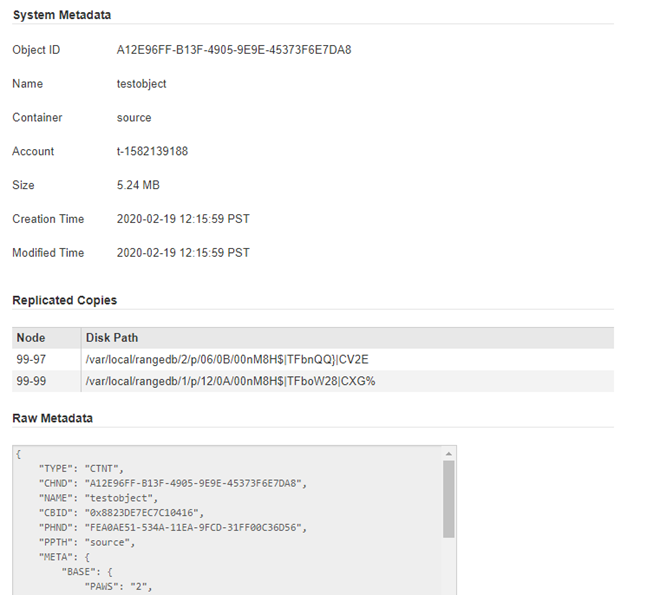Verify an ILM policy with object metadata lookup
 Suggest changes
Suggest changes


After you have activated an ILM policy, ingest representative test objects into the StorageGRID system, then perform an object metadata lookup to confirm that copies are being made as intended and placed in the correct locations.
You have an object identifier, which can be one of:
-
UUID: The object's Universally Unique Identifier.
-
CBID: The object's unique identifier within StorageGRID. You can obtain an object's CBID from the audit log. Enter the CBID in all uppercase.
-
S3 bucket and object key: When an object is ingested through the S3 interface, the client application uses a bucket and object key combination to store and identify the object. If the S3 bucket is versioned and you want to look up a specific version of an S3 object using the bucket and object key, you have the version ID.
-
Ingest the object.
-
Select ILM > Object metadata lookup.
-
Type the object's identifier in the Identifier field. You can enter a UUID, CBID, or S3 bucket/object-key.
-
Optionally, enter a version ID for the object (S3 only).
-
Select Look Up.
The object metadata lookup results appear. This page lists the following types of information:
-
System metadata, such as object ID (UUID), result type (object, delete marker, S3 bucket), and logical size of the object. Refer to the example screenshot below for more details.
-
Any custom user metadata key-value pairs associated with the object.
-
For S3 objects, any object tag key-value pairs associated with the object.
-
For replicated object copies, the current storage location of each copy.
-
For erasure-coded object copies, the current storage location of each fragment.
-
For object copies in a Cloud Storage Pool, the location of the object, including the name of the external bucket and the object's unique identifier.
-
For segmented objects and multipart objects, a list of object segments including segment identifiers and data sizes. For objects with more than 100 segments, only the first 100 segments are shown.
-
All object metadata in the unprocessed, internal storage format. This raw metadata includes internal system metadata that is not guaranteed to persist from release to release.
-
-
Confirm that the object is stored in the correct location or locations and that it's the correct type of copy.
If the Audit option is enabled, you can also monitor the audit log for the ORLM Object Rules Met message. The ORLM audit message can provide you with more information about the status of the ILM evaluation process, but it can't give you information about the correctness of the object data's placement or the completeness of the ILM policy. You must evaluate this yourself. For details, see Review audit logs.
The following example shows the object metadata lookup results for an S3 test object that is stored as two replicated copies.

|
The following screenshot is an example. Your results will vary depending on your StorageGRID version. |



